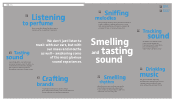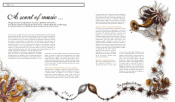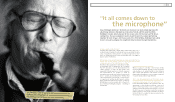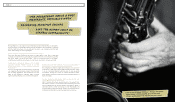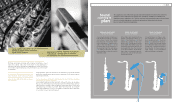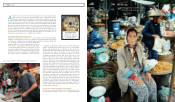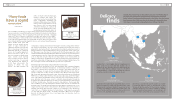Sennheiser 2010 Annual Report Download - page 12
Download and view the complete annual report
Please find page 12 of the 2010 Sennheiser annual report below. You can navigate through the pages in the report by either clicking on the pages listed below, or by using the keyword search tool below to find specific information within the annual report.
23
WINE’S SIREN S ONG
The palate
has ears
Red wine tastes better with the Rolling Stones,
while Kylie Minogue provides the perfect accompaniment
to white wine. Why music is proving to be the most
noble of flavor enhancers.
A tip for the true wine
connoisseur: From now
on, pair your wines
both to your selection
of food and music.
A
vintner in distant Chile monasticizes his grapes with Gregorian chants. And in not so austere
Austria, a winegrower plays Muzak to soothe the fermentation process. The relationship
between wine and music is bearing ever-stranger fruit. It used to be so simple: a good meal
and the right wine. And, of course, the perfect music. If a sommelier wasn’t around to instruct us
in what vine’s noble juice was suitable to which meal, in a pinch, we always had the bottle’s label
to fall back on. Music was simply a matter of taste. Tempi passati. However, ever since Scottish
researchers discovered that music has a measurable impact on how we perceive wine, the time of
wildly selecting background music has become a thing of the past. A hint of Kylie Minogue makes
a Riesling spritzy; the Rolling Stones spices up a red wine. After making an extensive study of wine
and song, a team led by psychologist Dr. Adrian North and consumer researchers have discovered
that the palate has ears.
We taste what we hear
Research isn’t always dry. At least not when
academics at Heriot-Watt University divided 250
volunteers into five different groups for an exclu-
sive wine tasting. As the fortunate test subjects
sipped various types of wine, four groups were
serenaded by different kinds of music. The control
group drank their wine in silence. Taste-testers
selected to partake in the lively wine tasting were
then asked to describe the different wines. Results
were startling: wine tasted significantly different
depending on whether or not music was being
played in the background. And that’s not all. The
music created a mood that directly impacted the
test subjects’ sense of taste.
Proving that we taste what we hear, Cabernet Sauvignon tasted
60 percent richer and more robust when listening to a powerful
piece of classical music, while white wine tasted particularly lively
and fresh when enjoyed to light pop music. Katy Perry gets
our tongues jamming to Chardonnay. Strong red wines with
tobacco, cocoa or wood notes have our tongues grooving to jazz
and the earthy soul music of Seal and Söhne Mannheims. Dr.
North’s research was based on a theory that suggests that music
stimulates specific areas of the brain. By the time the wine is
usually served, any music being played has already stimulated
the areas that prime the palate. In psychology, this is called
cognitive priming. As North explains his results, “It is widely
acknowledged within the scientific community that music affects
“It is widely acknowledged
within the scientific
community that music
affects behavior …”
DR . AD R IA N N O R T H, HE RI OT- W AT T U NI V E R SIT Y E DI N BU RG H




